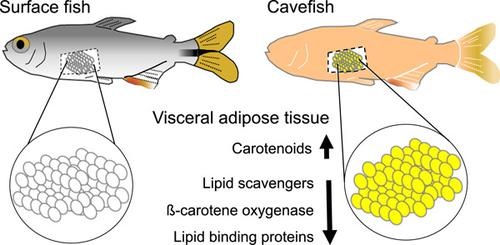当前位置:
X-MOL 学术
›
J. Exp. Zool. B Mol. Dev. Evol.
›
论文详情
Our official English website, www.x-mol.net, welcomes your
feedback! (Note: you will need to create a separate account there.)
Genetic architecture underlying changes in carotenoid accumulation during the evolution of the blind Mexican cavefish, Astyanax mexicanus.
Journal of Experimental Zoology-B: Molecular and Developmental Evolution ( IF 1.8 ) Pub Date : 2020-06-02 , DOI: 10.1002/jez.b.22954 Misty R Riddle 1 , Ariel C Aspiras 1 , Fleur Damen 1 , John N Hutchinson 2 , Daniel J-F Chinnapen 3, 4 , Julius Tabin 1 , Clifford J Tabin 1
Journal of Experimental Zoology-B: Molecular and Developmental Evolution ( IF 1.8 ) Pub Date : 2020-06-02 , DOI: 10.1002/jez.b.22954 Misty R Riddle 1 , Ariel C Aspiras 1 , Fleur Damen 1 , John N Hutchinson 2 , Daniel J-F Chinnapen 3, 4 , Julius Tabin 1 , Clifford J Tabin 1
Affiliation

|
Carotenoids are lipid‐soluble yellow to orange pigments produced by plants, bacteria, and fungi. They are consumed by animals and metabolized to produce molecules essential for gene regulation, vision, and pigmentation. Cave animals represent an interesting opportunity to understand how carotenoid utilization evolves. Caves are devoid of light, eliminating primary production of energy through photosynthesis and, therefore, limiting carotenoid availability. Moreover, the selective pressures that favor carotenoid‐based traits, like pigmentation and vision, are relaxed. Astyanax mexicanus is a species of fish with multiple river‐adapted (surface) and cave‐adapted populations (i.e., Tinaja, Pachón, Molino). Cavefish exhibit regressive features, such as loss of eyes and melanin pigment, and constructive traits, like increased sensory neuromasts and starvation resistance. Here, we show that, unlike surface fish, Tinaja and Pachón cavefish accumulate carotenoids in the visceral adipose tissue. Carotenoid accumulation is not observed in Molino cavefish, indicating that it is not an obligatory consequence of eye loss. We used quantitative trait loci mapping and RNA sequencing to investigate genetic changes associated with carotenoid accumulation. Our findings suggest that multiple stages of carotenoid processing may be altered in cavefish, including absorption and transport of lipids, cleavage of carotenoids into unpigmented molecules, and differential development of intestinal cell types involved in carotenoid assimilation. Our study establishes A. mexicanus as a model to study the genetic basis of natural variation in carotenoid accumulation and how it impacts physiology.
中文翻译:

在墨西哥盲眼洞穴鱼 Astyanax mexicanus 的进化过程中,类胡萝卜素积累变化的遗传结构是潜在的。
类胡萝卜素是由植物、细菌和真菌产生的脂溶性黄色至橙色色素。它们被动物消耗并代谢产生基因调节、视力和色素沉着所必需的分子。洞穴动物为了解类胡萝卜素的利用如何演变提供了一个有趣的机会。洞穴缺乏光线,消除了通过光合作用产生的初级能量,因此限制了类胡萝卜素的可用性。此外,有利于类胡萝卜素特征(如色素沉着和视力)的选择压力也得到了放松。 Astyanax mexicanus是一种具有多种河流适应(水面)和洞穴适应种群(即 Tinaja、Pachón、Molino)的鱼类。洞穴鱼表现出退化特征,例如眼睛和黑色素的丧失,以及建设性特征,例如感觉神经丘的增加和饥饿抵抗力。在这里,我们发现,与表层鱼类不同,蒂纳哈和帕琼洞穴鱼在内脏脂肪组织中积累类胡萝卜素。在莫利诺穴居鱼中没有观察到类胡萝卜素积累,这表明这不是失眼的必然结果。我们使用数量性状位点作图和 RNA 测序来研究与类胡萝卜素积累相关的遗传变化。我们的研究结果表明,类胡萝卜素加工的多个阶段可能在洞穴鱼中发生改变,包括脂质的吸收和运输、类胡萝卜素裂解成无色素的分子以及参与类胡萝卜素同化的肠道细胞类型的差异发育。我们的研究建立了A. mexicanus作为模型来研究类胡萝卜素积累自然变异的遗传基础及其对生理的影响。
更新日期:2020-06-02
中文翻译:

在墨西哥盲眼洞穴鱼 Astyanax mexicanus 的进化过程中,类胡萝卜素积累变化的遗传结构是潜在的。
类胡萝卜素是由植物、细菌和真菌产生的脂溶性黄色至橙色色素。它们被动物消耗并代谢产生基因调节、视力和色素沉着所必需的分子。洞穴动物为了解类胡萝卜素的利用如何演变提供了一个有趣的机会。洞穴缺乏光线,消除了通过光合作用产生的初级能量,因此限制了类胡萝卜素的可用性。此外,有利于类胡萝卜素特征(如色素沉着和视力)的选择压力也得到了放松。 Astyanax mexicanus是一种具有多种河流适应(水面)和洞穴适应种群(即 Tinaja、Pachón、Molino)的鱼类。洞穴鱼表现出退化特征,例如眼睛和黑色素的丧失,以及建设性特征,例如感觉神经丘的增加和饥饿抵抗力。在这里,我们发现,与表层鱼类不同,蒂纳哈和帕琼洞穴鱼在内脏脂肪组织中积累类胡萝卜素。在莫利诺穴居鱼中没有观察到类胡萝卜素积累,这表明这不是失眼的必然结果。我们使用数量性状位点作图和 RNA 测序来研究与类胡萝卜素积累相关的遗传变化。我们的研究结果表明,类胡萝卜素加工的多个阶段可能在洞穴鱼中发生改变,包括脂质的吸收和运输、类胡萝卜素裂解成无色素的分子以及参与类胡萝卜素同化的肠道细胞类型的差异发育。我们的研究建立了A. mexicanus作为模型来研究类胡萝卜素积累自然变异的遗传基础及其对生理的影响。











































 京公网安备 11010802027423号
京公网安备 11010802027423号